CADILLAC SEVILLE 1995 4.G Owners Manual
Manufacturer: CADILLAC, Model Year: 1995, Model line: SEVILLE, Model: CADILLAC SEVILLE 1995 4.GPages: 410, PDF Size: 19.98 MB
Page 291 of 410
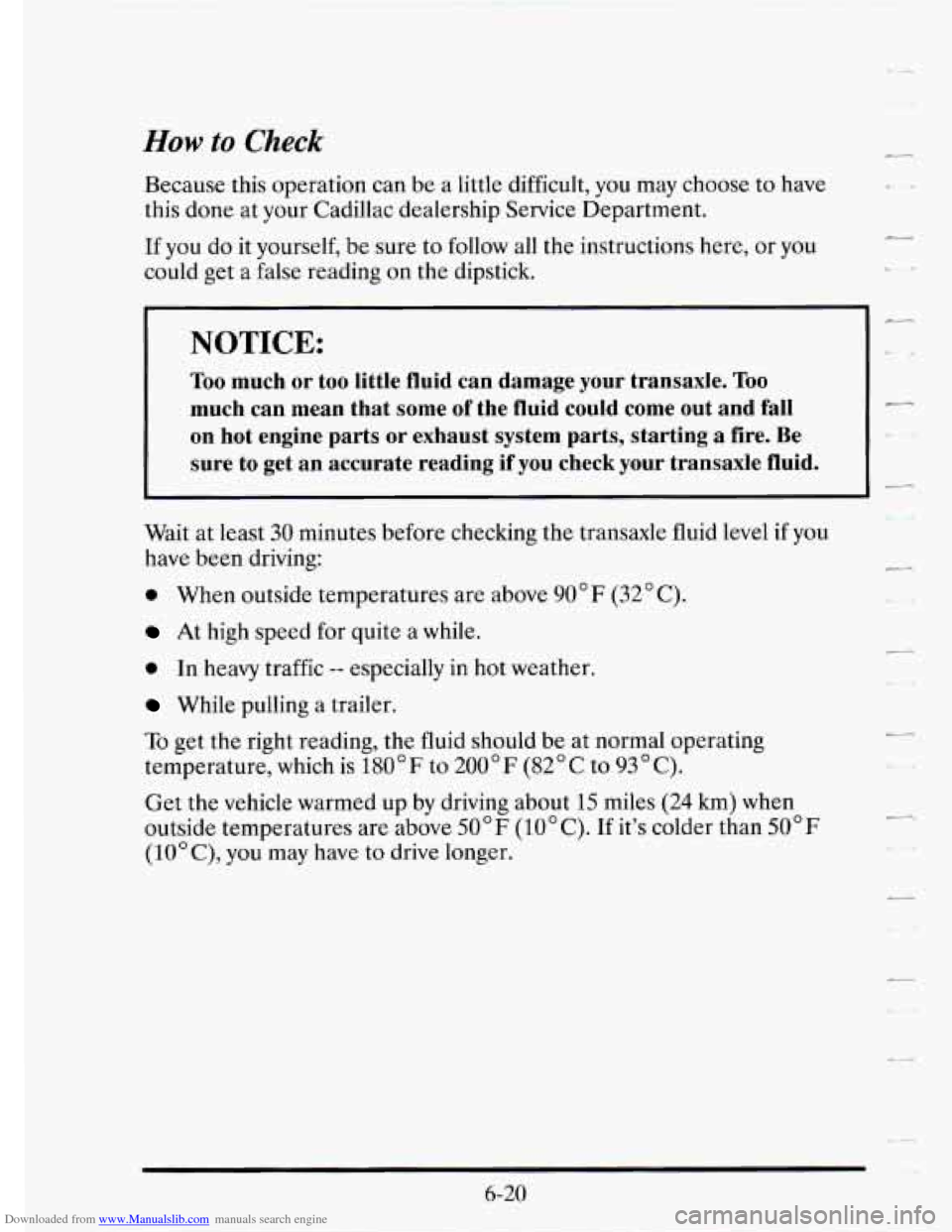
Downloaded from www.Manualslib.com manuals search engine How to Check
Because this operation can be a little difficult, you may choose to have
this done at your Cadillac dealership Service Department.
If
you do it yourself, be sure to follow all the instructions here, or you
could get a false reading on the dipstick.
NOTICE:
LI
Too much or too little fluid can damage your transaxle. Too
much can mean that some of the fluid could come out and fall l-
on hot engine parts or exhaust system parts, starting a fire. Be
sure to get an accurate reading
if you check your transaxle fluid.
Wait at least 30 minutes before checking the transaxle fluid level if you
have been driving:
0 When outside temperatures are above 90 " F (32 C).
At high speed for quite a while.
0 In heavy traffic -- especially in hot weather.
While pulling a trailer.
To get the right reading, the fluid should be at normal operating
temperature, which is
180 " F to 200 F (82 C to 93 " C).
Get the vehicle warmed up by driving about 15 miles (24 km) when
outside temperatures are above
50°F (10°C). If it's colder than 50°F
(lO°C), you may have to drive longer.
6-20
Page 292 of 410
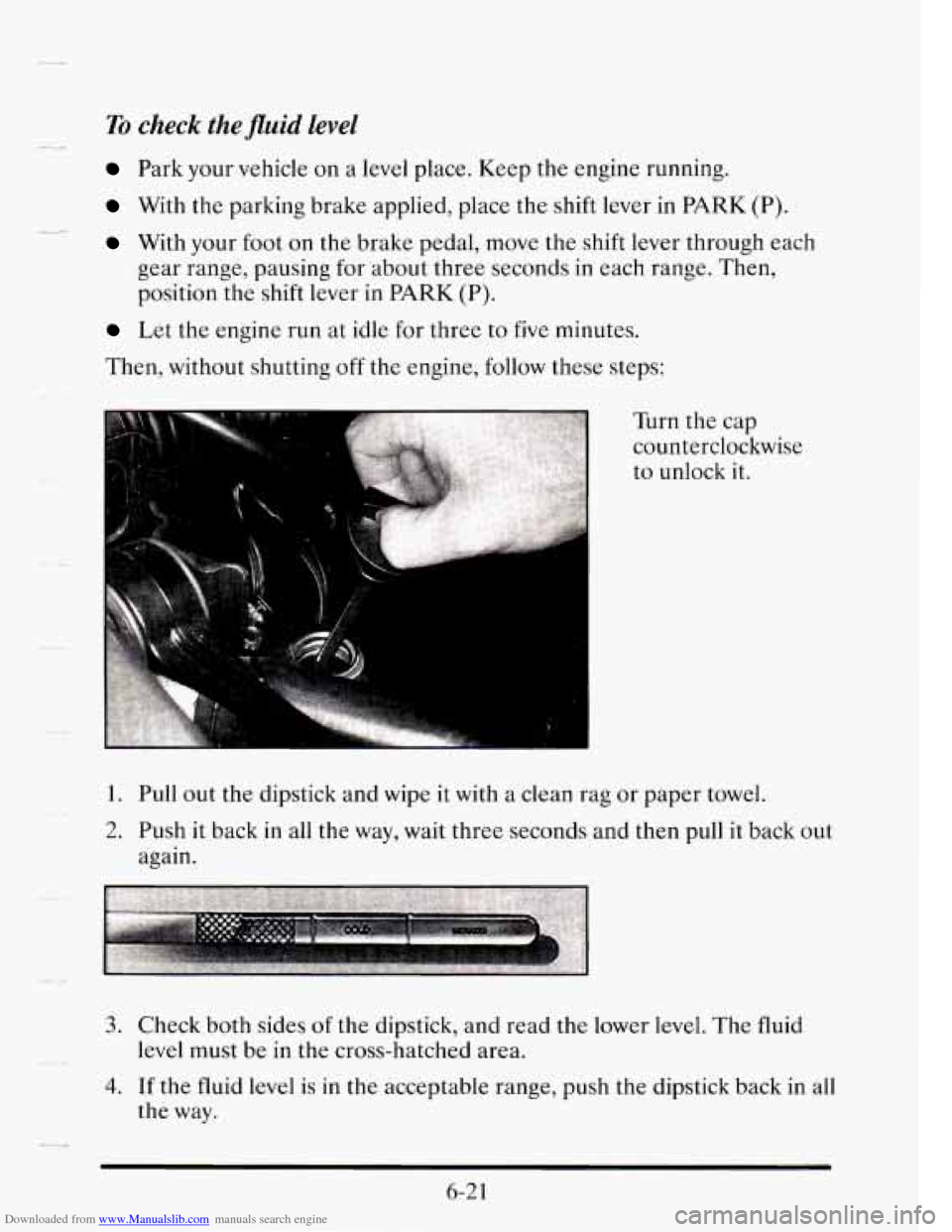
Downloaded from www.Manualslib.com manuals search engine To check the fluid level
;c-
Park your vehicle on a level place. Keep the engine running.
With the parking brake applied, place the shift lever in PARK (P).
With your foot on the brake pedal, move the shift lever through each
gear range, pausing for about three seconds
in each range. Then,
position the shift lever
in PARK (P).
Let the engine run at idle for three to five minutes.
Then, without shutting off the engine, follow these steps:
Turn the cap
counterclockwise
to unlock it.
1. Pull out the dipstick and wipe it with a clean rag or paper towel.
2. Push it back in all the way, wait three seconds and then pull it back out
again.
3. Check both sides of the dipstick, and read the lower level. The fluid
4. If the fluid level is in the acceptable range, push the dipstick back in all
level
must be in the cross-hatched area.
the way.
6-2 1
Page 293 of 410
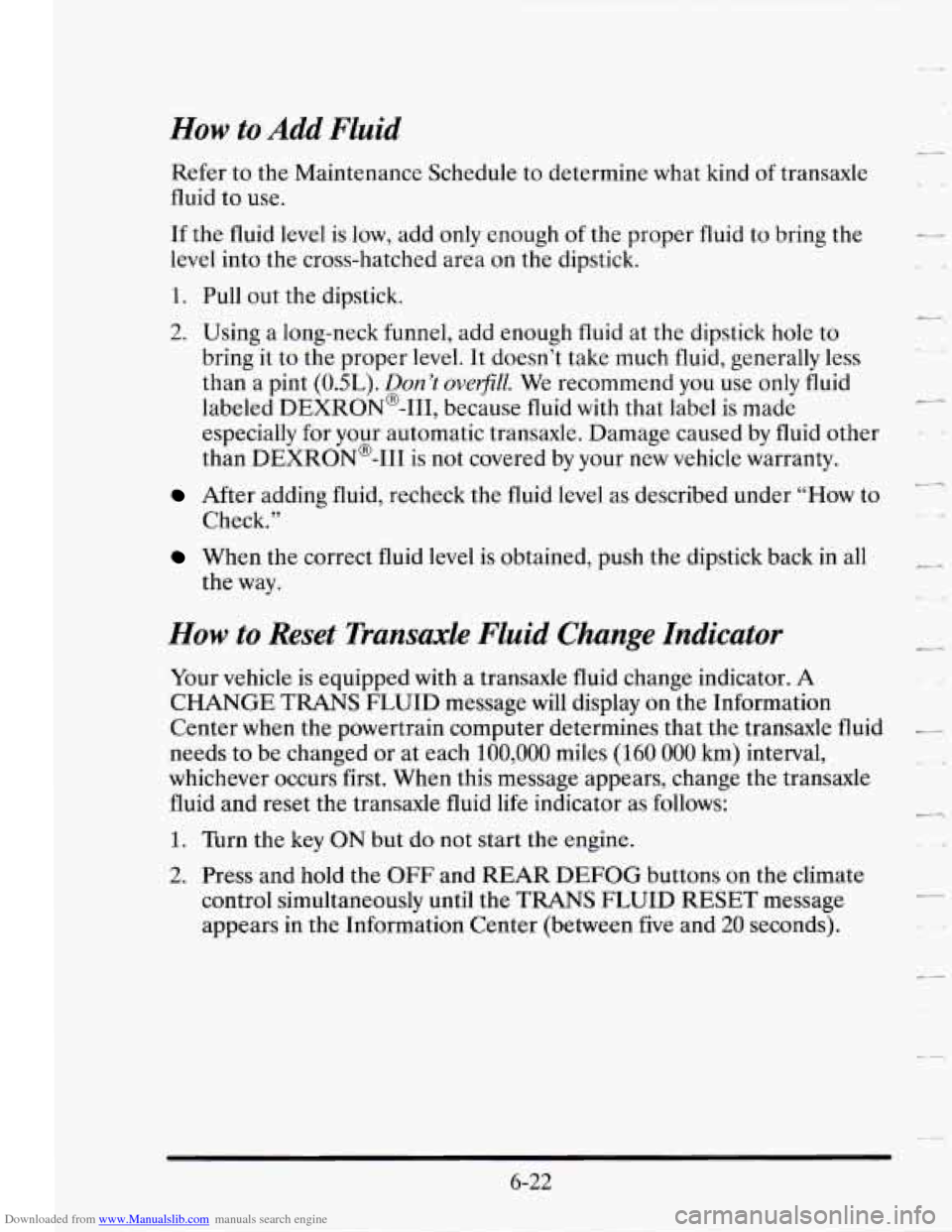
Downloaded from www.Manualslib.com manuals search engine How to Add Fluid
Refer to the Maintenance Schedule to determine what kind of transaxle
fluid to use.
If the fluid level is low, add only enough
of the proper fluid to bring the
level into the cross-hatched area on the dipstick.
1. Pull out the dipstick.
2. Using a long-neck funnel, add enough fluid at the dipstick hole to
bring it to the proper level. It doesn’t take much fluid, generally less
than a pint (OSL).
Don’t ove@ZZ. We recommend you use only fluid
labeled DEXRON@-111, because fluid with that label is made
especially for your automatic transaxle. Damage caused by fluid other
than DEXRON@-I11 is
not covered by your new vehicle warranty.
After adding fluid, recheck the fluid level as described under “How to
Check.”
When the correct fluid level is obtained, push the dipstick back in all
the way.
How to Reset Transaxle Fluid Change Indicator
-.
Your vehicle is equipped with a transaxle fluid change indicator. A
CHANGE TRANS FLUID message will display on the Information
Center when the powertrain computer determines that the transaxle fluid
-
needs to be changed or at each 100,000 miles (160 000 km) interval,
whichever occurs first. When this message appears, change the transaxle
fluid and reset the transaxle fluid life indicator as follows:
1. Turn the key ON but do not start the engine.
2. Press and hold the OFF and REAR DEFOG buttons on the climate
control simultaneously until the
TRANS FLUID RESET message
appears in the Information Center (between five and
20 seconds).
6-22
Page 294 of 410
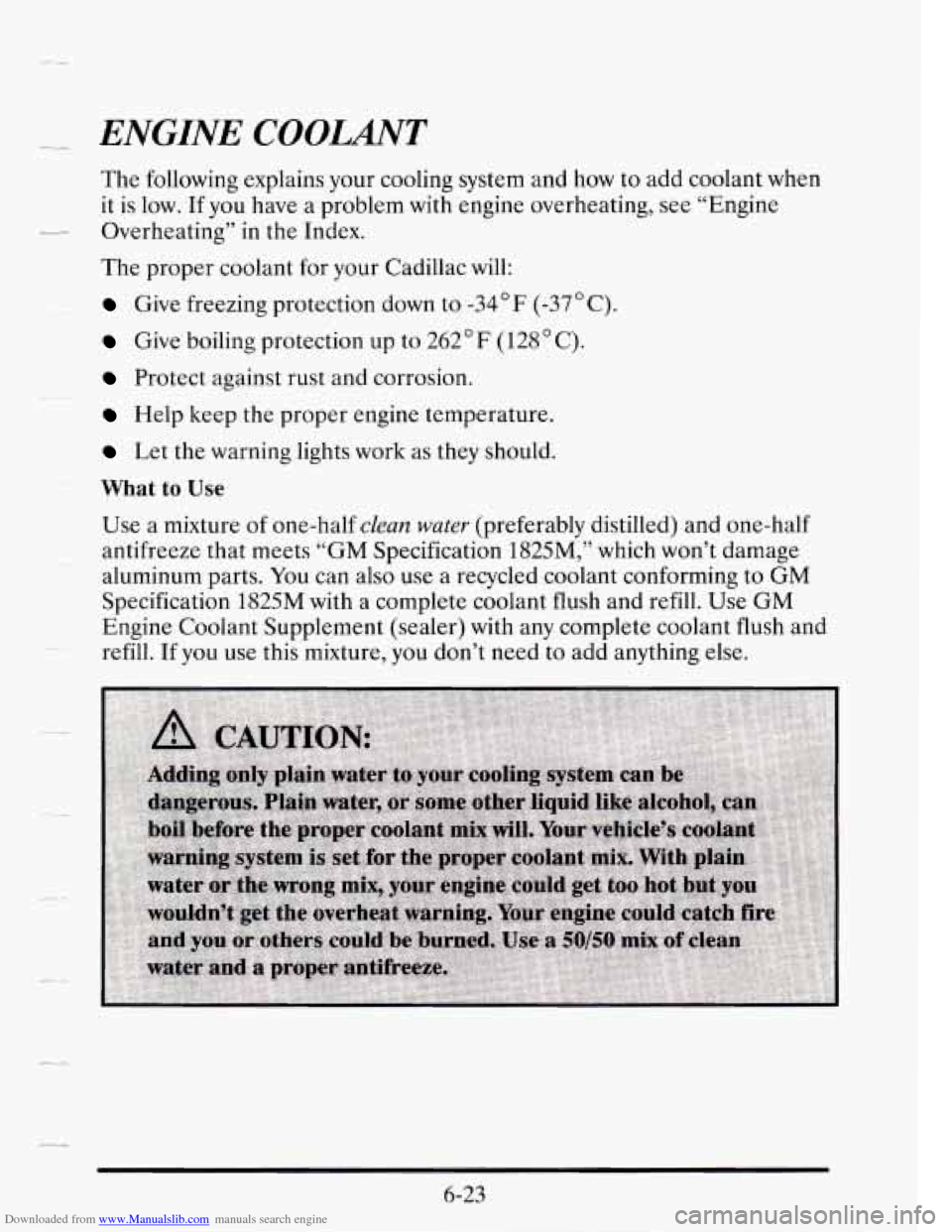
Downloaded from www.Manualslib.com manuals search engine -- ENGINE COOLANT
The following explains your cooling system and how to add coolant when
it
is low. If you have a problem with engine overheating, see “Engine
The proper coolant
for your Cadillac will:
Give freezing protection down to -34OF (-37OC).
m_ Overheating” in the Index.
Give boiling protection up to 262°F (128°C).
Protect against rust and corrosion.
Help keep the proper engine temperature.
Let the warning lights work as they should.
What to Use
Use a mixture of one-half clean water (preferably distilled) and one-half
antifreeze that meets
“GM Specification 1825M,” which won’t damage
aluminum parts. You can also use a recycled coolant conforming to GM
Specification 1825M with a complete coolant flush and refill. Use GM
Engine Coolant Supplement (sealer) with any complete coolant flush and
refill. If you use this mixture,
you don’t need to add anything else.
6-23
Page 295 of 410
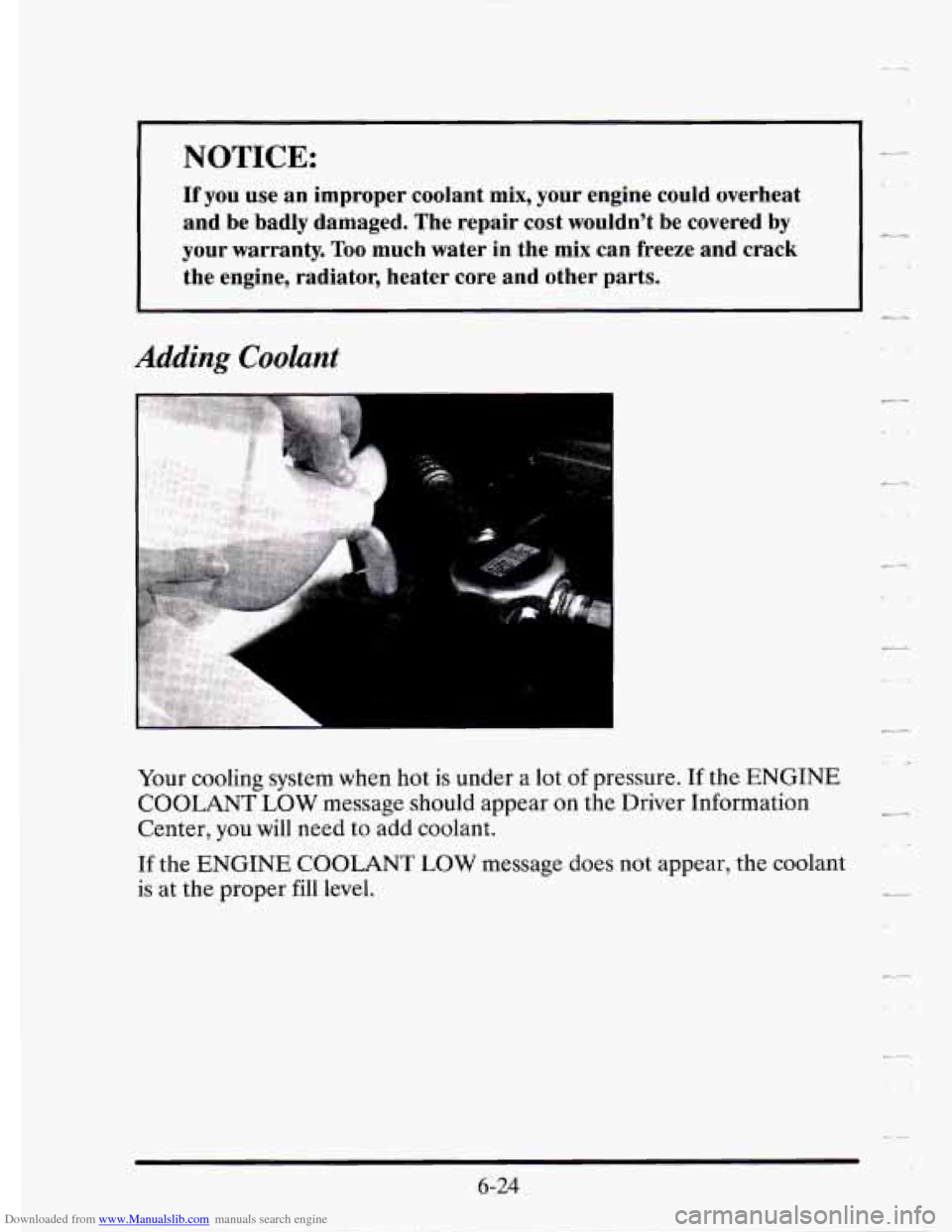
Downloaded from www.Manualslib.com manuals search engine I NOTICE: I-
If you use an improper coolant mix, your engine could overheat
and be badly damaged. The repair cost wouldn't be covered by
your warranty.
Too much water in the mix can freeze and crack I-
the engine, radiator, heater core and other parts.
c_
Adding Coolant
Your cooling system when hot is under a lot of pressure. If the ENGINE
COOLANT LOW message should appear on the Driver Information
Center,
you will need to add coolant.
If the ENGINE COOLANT LOW message does not appear, the coolant
is at the proper
fill level.
6-24
Page 296 of 410
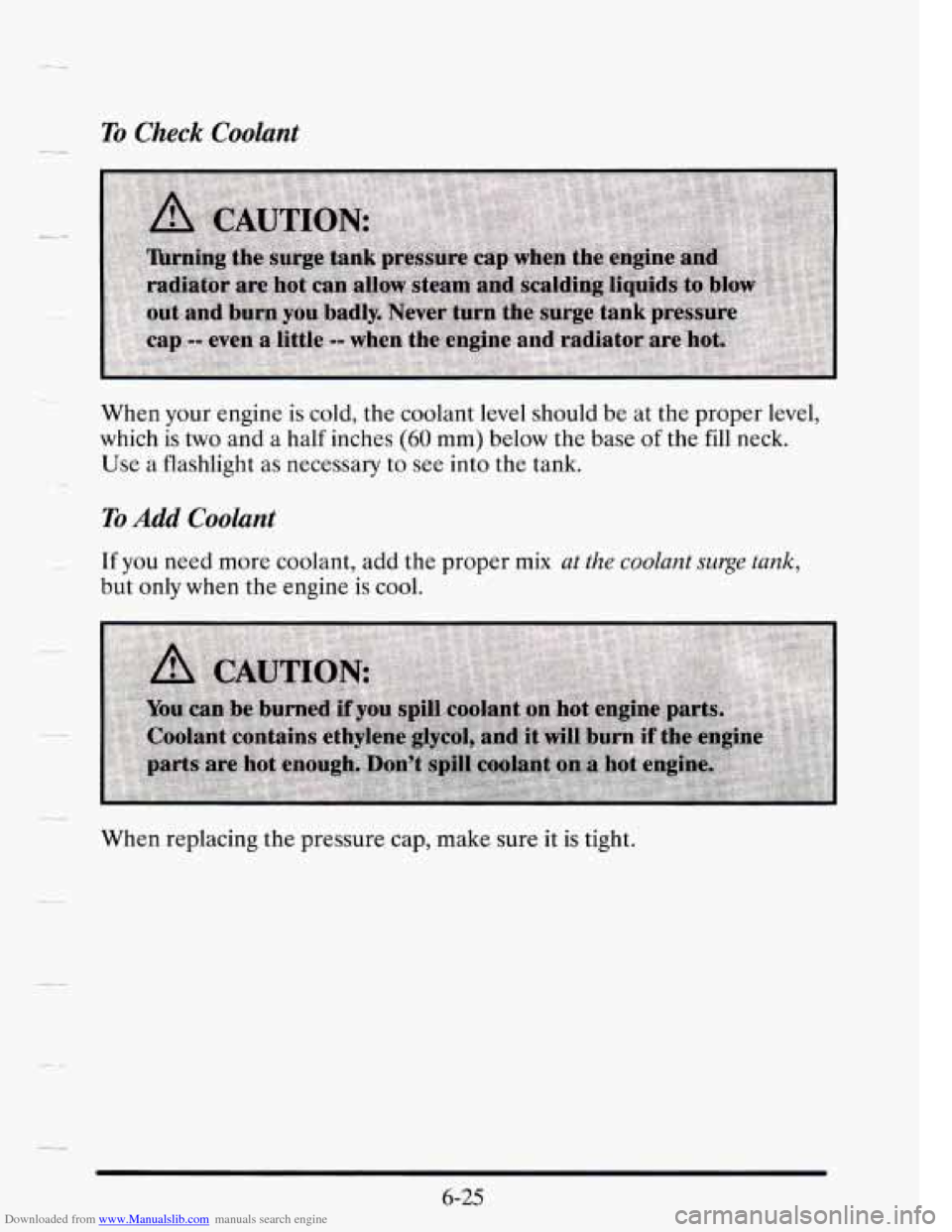
Downloaded from www.Manualslib.com manuals search engine To Check Coolant
When your engine is cold, the coolant level should be at the proper level,
which is
two and a half inches (60 mm) below the base of the fill neck.
Use a flashlight as necessary to see into the tank.
To Add Coolant
If you need more coolant, add the proper mix at the coolant surge tank,
but only when the engine is cool.
__
When replacing the pressure cap, make sure it is tight.
c-
6-25
Page 297 of 410
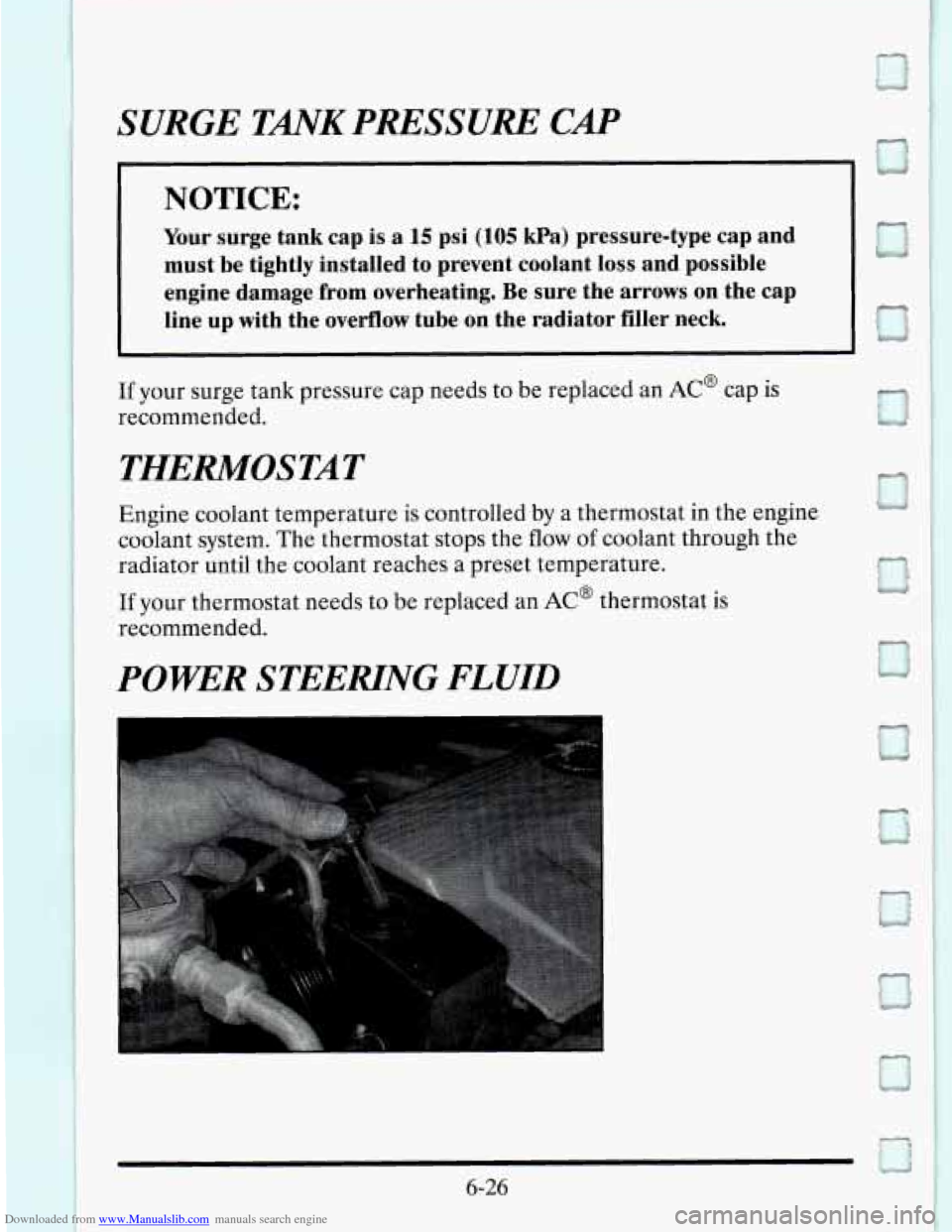
Downloaded from www.Manualslib.com manuals search engine SURGE TANK PRESSURE CAP
NOTICE:
Your surge tank cap is a 15 psi (105 Wa) pressure-type cap and
must be tightly installed to prevent coolant loss and possible
engine damage from overheating. Be sure the arrows on the cap
line up with the overflow tube on the radiator filler neck.
If your surge tank pressure cap needs to be replaced an AC' cap is
recommended.
THERMOSTAT
Engine coolant temperature is controlled by a thermostat in the engine
coolant system. The thermostat stops the
flow of coolant through the
radiator until the coolant reaches a preset temperature.
If your thermostat needs to be replaced an AC@ thermostat is
recommended.
POWER STEERING FLUID
Page 298 of 410
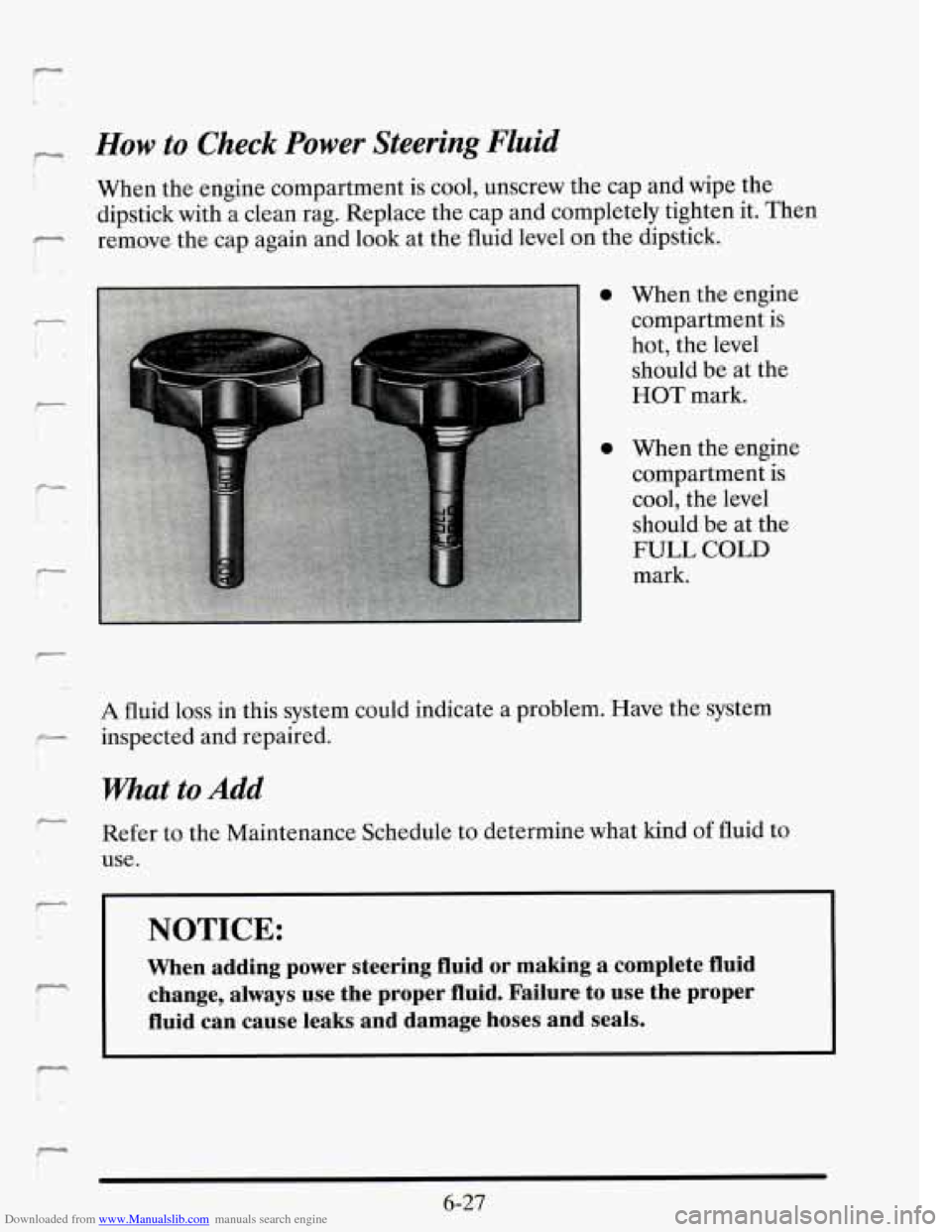
Downloaded from www.Manualslib.com manuals search engine - How to Check Power Steering Fluid
When the engine compartment is cool, unscrew the cap and wipe the
dipstick with a clean rag. Replace the cap and completely tighten it. Then
- remove the cap again and look at the fluid level on the dipstick.
0
0 When the engine compartment is
hot, the level
should be at the
HOT mark.
When the engine compartment is
cool, the level
should be at the
FULL COLD
mark.
A fluid loss in this system could indicate a problem. Have the system
,- inspected and repaired.
What to Add
r Refer to the Maintenance Schedule to determine what kind of fluid to
use.
NOTICE:
When adding power steering fluid or making a complete fluid
change, always use the proper fluid. Failure to use the proper
fluid can cause leaks and damage hoses and seals.
n
6-27
Page 299 of 410
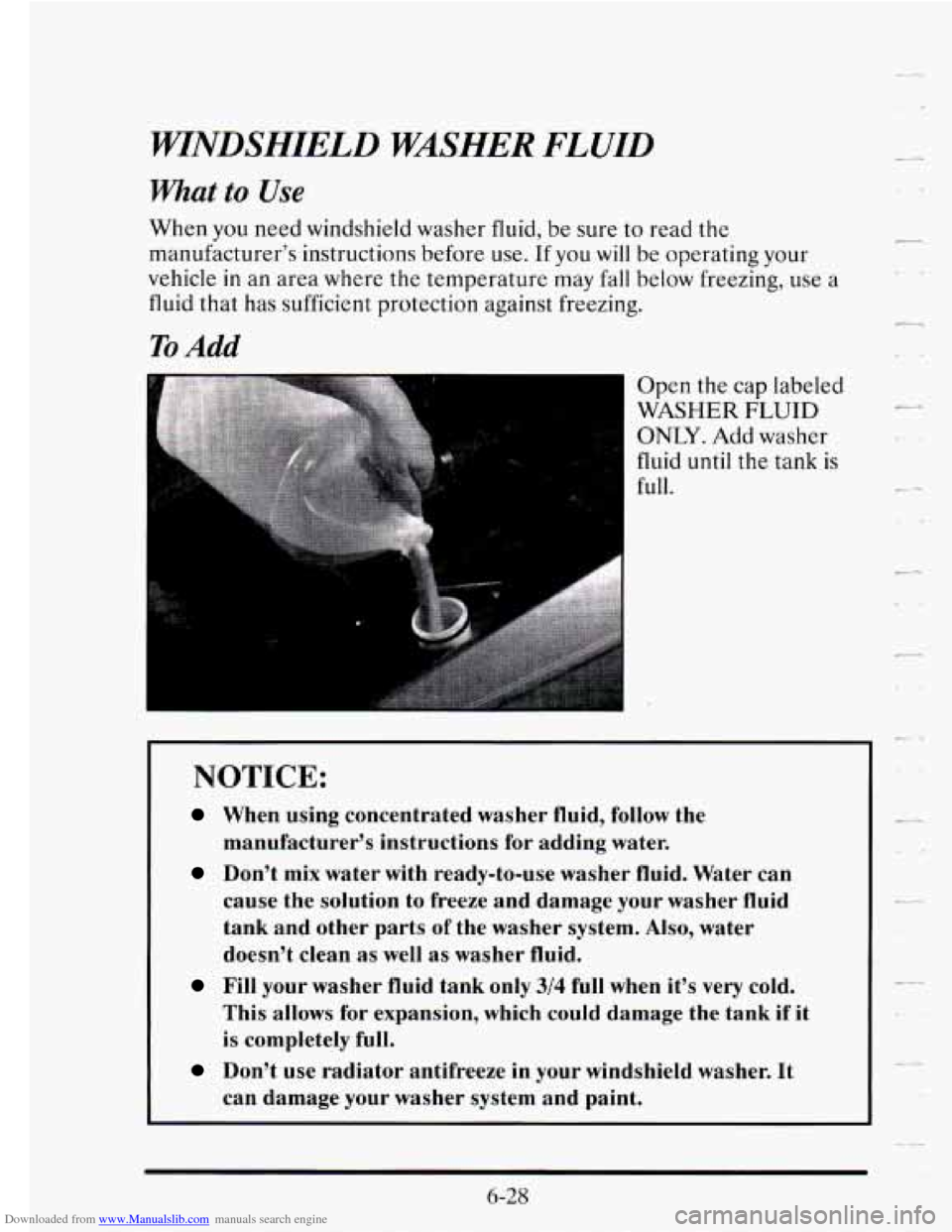
Downloaded from www.Manualslib.com manuals search engine WINDSHIELD WASHER FLUID
What to Use
When you need windshield washer fluid, be sure to read the
manufacturer’s instructions before use. If you
will be operating your
vehicle
in an area where the temperature may fall below freezing, use a
fluid that has sufficient protection against freezing.
To Add
Open the cap labeled
WASHER FLUID
ONLY. Add washer
fluid
until the tank is
full. 4
-.
I 1
NOTICE:
When using concentrated washer fluid, follow the
manufacturer’s instructions for adding water.
Don’t mix water with ready-to-use washer fluid. Water can
cause the solution to freeze and damage your washer fluid
tank and other parts
of the washer system. Also, water
doesn’t clean as well as washer fluid.
Fill your washer fluid tank only 3/4 full when it’s very cold.
This allows
for expansion, which could damage the tank if it
is completely full.
can damage your washer system and paint.
Don’t use radiator antifreeze in your windshield washer. It
I-
C-
6-28
Page 300 of 410
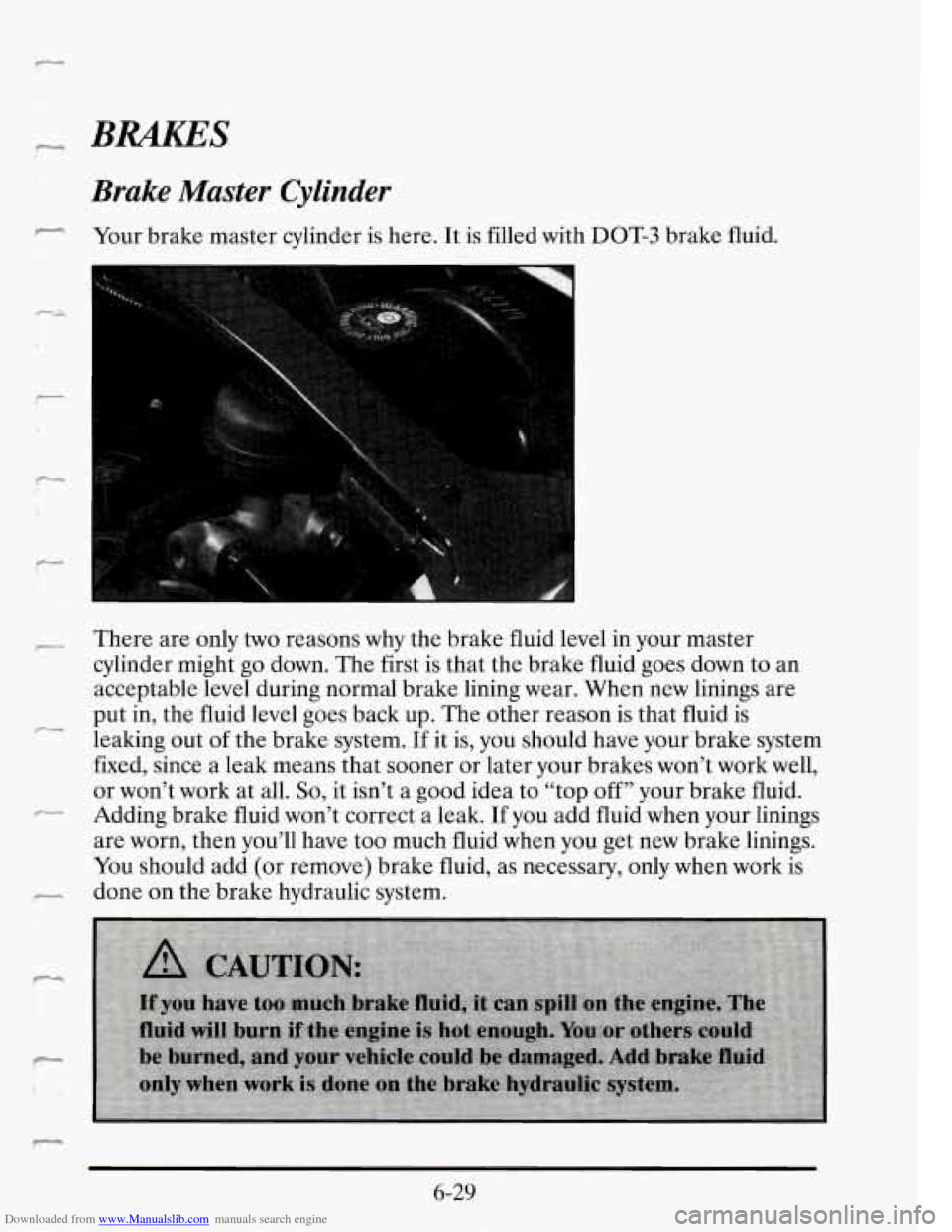
Downloaded from www.Manualslib.com manuals search engine Brake Master Cylinder
- Your brake master cylinder is here. It is filled with DOT-3 brake fluid.
r There are only two reasons why the brake fluid level in your master
cylinder might go down. The first is that the brake fluid goes down to an
acceptable level during normal brake lining wear. When new linings are
put in, the fluid level goes back
up. The other reason is that fluid is
leaking out of the brake system.
If it is, you should have your brake system
fixed, since a leak means that sooner or later your brakes won’t work well,
or won’t work at all.
So, it isn’t a good idea to “top off’’ your brake fluid.
are worn, then you’ll have too much fluid when you get new brake linings.
You should add (or remove) brake fluid, as necessary, only when work
is
done on the brake hydraulic system.
-
.c-- Adding brake fluid won’t correct a leak. If you add fluid when your linings
6-29